Emily Lakdawalla • Mar 30, 2016
LPSC 2016: So. Much. Ceres.
At last week's Lunar and Planetary Science Conference, I enjoyed a large number of talks about Ceres, which Dawn is now orbiting at an altitude of merely 385 kilometers. Several sessions worth of talks considered a wealth of new data that has been acquired since the last time I attended scientific sessions on Dawn, at lower altitudes and hence more detail. All that freshly acquired data made for talks bursting with pretty pictures and data but relatively thin on interpretation and with little coordination (yet) across data sets, which makes them a bit hard to summarize briefly. Deputy principal investigator Carol Raymond summed the situation up well at the press briefing: "Clearly, we have a lot of work to do to put together a self-consistent story among all these different data sets."
Dawn is very different from past asteroid missions. We've mostly encountered asteroids by flying quickly past each object, never to see them again. Dawn is not that kind of mission. It's been doing science at Ceres for more than a year now, beginning from a position of great distance. In discrete steps, over the course of the last year, it has journeyed closer to Ceres, getting more data at higher resolution with each incremental step closer. In a way, Dawn's single mission to Ceres encapsulates several distinct missions in the initial exploration of other worlds. From its Approach and then Survey orbits, Dawn first identified interesting spots on Ceres. From its High-Altitude Mapping Orbit (HAMO), Dawn generated global maps, in color and in three dimensions, generating a topographic base map for further studies. HAMO was at an altitude of 1470 kilometers; it began on August 17 and ended on October 23. HAMO included six mapping cycles to acquire Framing Camera images useful for developing a 3D terrain model, described here. Two of those mapping cycles (the second and fifth) included color data from the camera.
Now Dawn is in its Low-Altitude Mapping Orbit (LAMO), at an altitude of 385 kilometers, and is remapping the whole globe, but with added data from the Neutron Spectrometer. Dawn arrived in LAMO on December 16. It will remain there for the rest of its mission, which could go into early 2017 if the remaining two reaction wheels stay healthy. If one were to fail soon, Dawn would still complete its mission using only hydrazine thrusters, surviving into the beginning of August.
Each new altitude produces an even richer data set than the altitude before it. Each richer data set makes scientists go back and rewrite papers that weren't even done being written about the previous, lower-resolution global data set. I'd like to take a moment to tip my hat in respect to a science team that has to struggle to do science against the flood of newer, better data! It's a nice problem to have, though.
Before I get in to the content of the talks, I need to set the scene. A lot of the talks focused on differences in geology and composition among different craters or other landmarks, so here's a map of Ceres with named landmarks. Unlike at Pluto, all these Ceres names are formally approved by the IAU; the science team has prioritized getting their bearings, establishing this global context and common vocabulary before proceeding into the science.
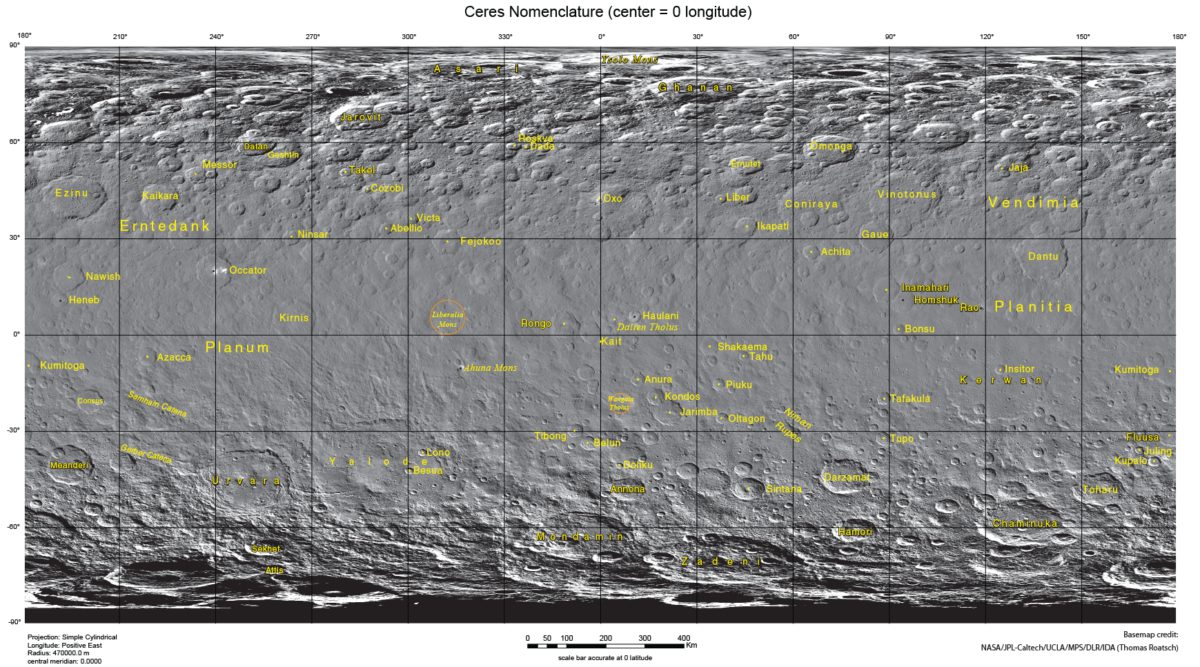
A few locations showed up repeatedly in talk after talk. These included craters with bright spots or splashes like Occator, Haulani, Ikapati, and Oxo. I include amazing pictures of Occator below. They haven't released LAMO-resolution images of Haulani or Oxo yet, but you can see them as the two bright splashes on Ceres in this color view:
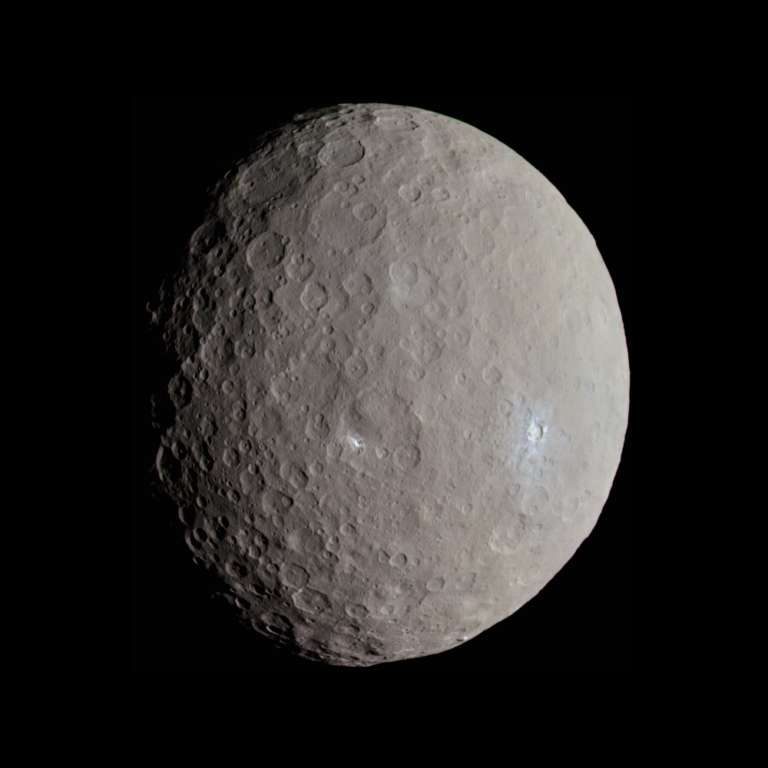
The primary scientific goal of LAMO is to map Ceres for the first time with GRaND, Dawn's neutron spectrometer. In talks and at a press briefing last Tuesday, Tom Prettyman reported on the status of GRaND's LAMO mapping to date. The news is good so far: the instrument is working well, and they are getting results that make sense. They see an enrichment of hydrogen in the subsurface toward the poles, with the poles showing counts of slow neutrons 40% higher than near the equator. This is much more dynamic range than GRaND observed at Vesta, which had only 6% dynamic range across its surface. Overall, the early compositional information from GRaND is in line with that of carbonaceous chondrites (like CM and CI chondrites).
LAMO isn't just for neutron spectroscopy, though. Very recently, the Framing Camera completed the acquisition of a global map of Ceres from its LAMO altitude, covering the entire globe at 35 meters per pixel. This is a major accomplishment, made all the more amazing by the loss of two of Dawn's reaction wheels. In order to complete the map, Dawn mapped Ceres over two complete orbital cycles. The first map covered much of the globe, and then a second orbital cycle allowed Dawn to fill in gaps. To conserve fuel and also to maintain constant viewing geometry and illumination conditions, Dawn almost never pointed away from directly downward, patiently waiting for the right spots to appear underneath the spacecraft at the right time. A gap in imaging stubbornly remained over Occator crater and its bright spots throughout almost the entire imaging campaign; it was only filled in February, and final gaps were covered this month. Here's a fun animation showing the slow buildup of the global map.
Filling in that final gap allowed the team to finally release some spectacular images of Occator, including a high-resolution mosaic in which you can see the diverse features on the crater floor. There was also a zoom in on the region with the bright spots, colored with lower-resolution imagery acquired from the high-altitude mapping orbit. Here is the mosaic:
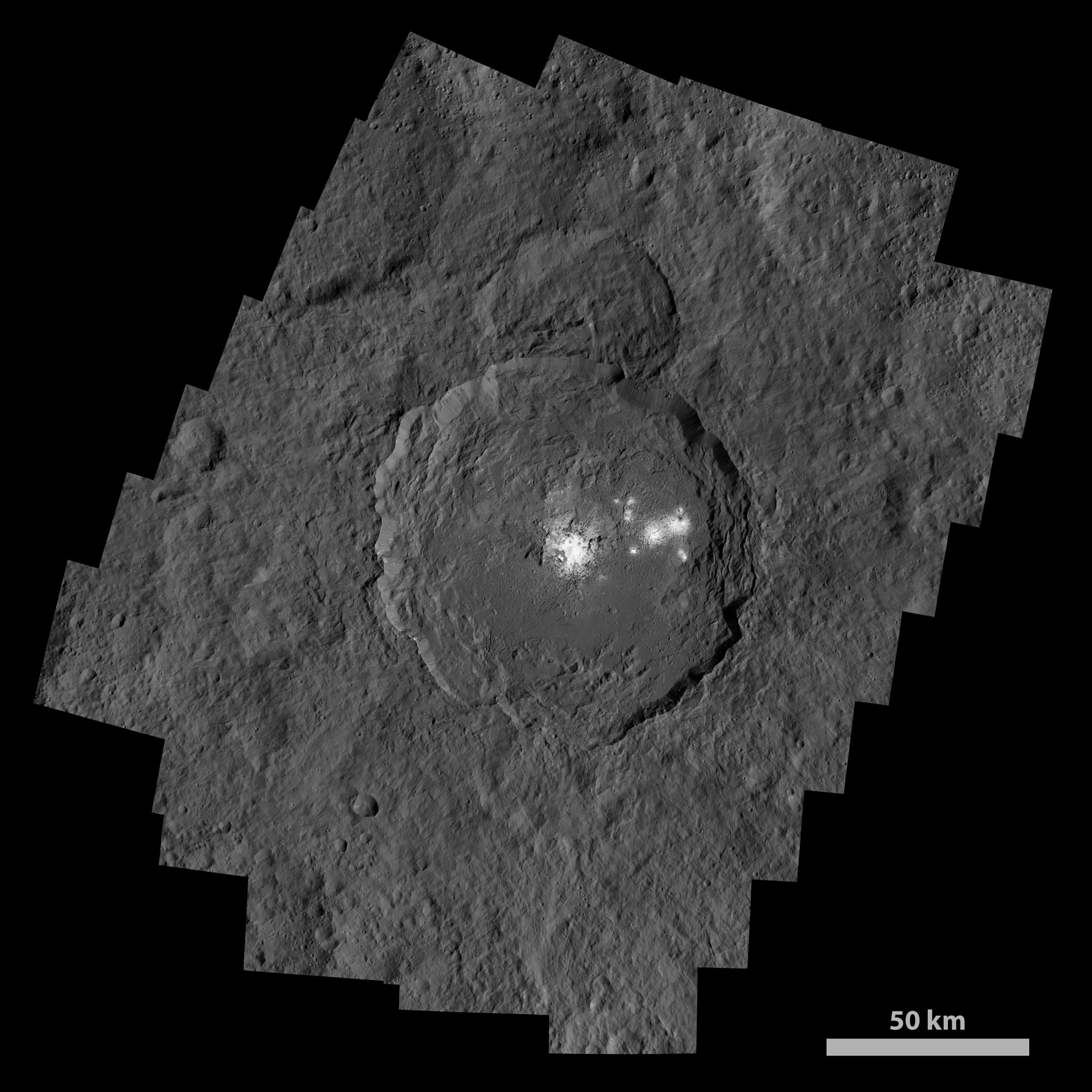
Everybody loves Occator's bright spots, but they're not the only cool thing about the crater. At the conference, Paul Schenk pointed out the different sets of fractures that cut Occator's floor. Some of them are "annular" -- they form rings around the center of the crater. In fact, annular fractures are visible for quite a distance outside the crater, on its ejecta. Schenk said that these fractures within ejecta "are common on fresh craters on Ceres, but they are not seen in the Saturn system." About a third of Occator is filled with knobby or ropey fill, with "lobate flow margins." Each of those lobes represents material that squirted between topographic highs to pond in topographic lows. Schenk showed a photo of the flow Tycho crater on the Moon, which looks surprisingly similar to Occator on Ceres. So, he said, the flowey material "is probably impact melt, but we can't discount post-impact volcanism, so we need to do detailed mapping to discriminate between the two."
The high-resolution color photo of Occator's spots is probably the best thing I saw at the whole conference. Schenk shared it in his talk. Here it is. I'm not going to talk about it until you have a chance to enlarge it and enjoy it and see what you see. Go ahead, it's worth it.
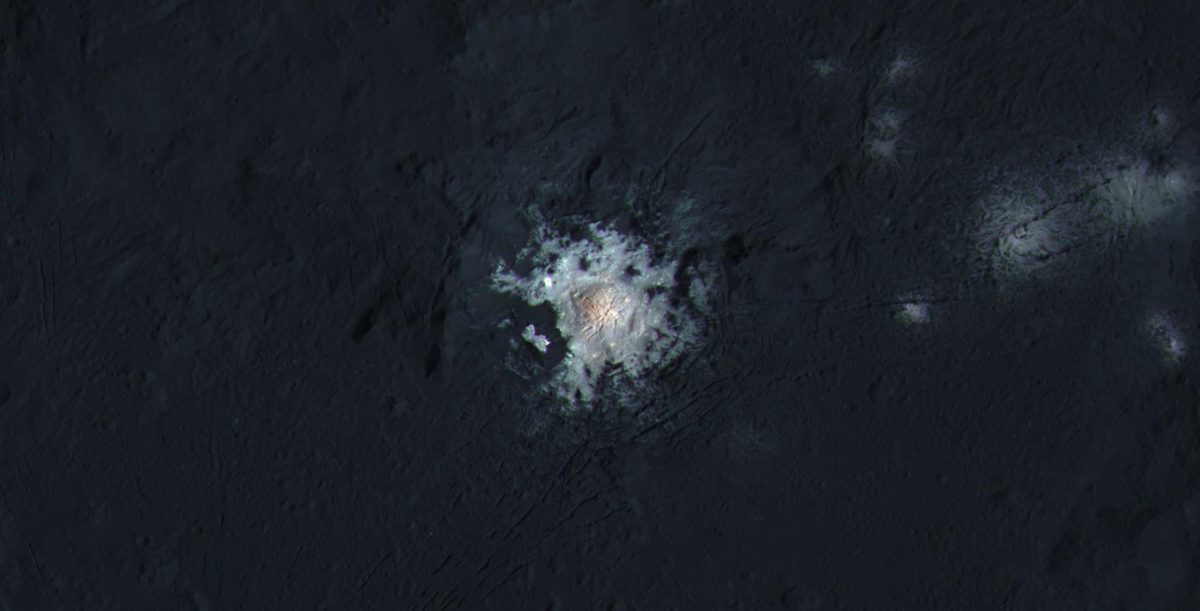
You can see more detail in this grayscale version. I'm fascinated by the spots to the east of the central bright spot, the way that the bright stuff forms a deposit around what appear to be vents, if I'm not mistaken.
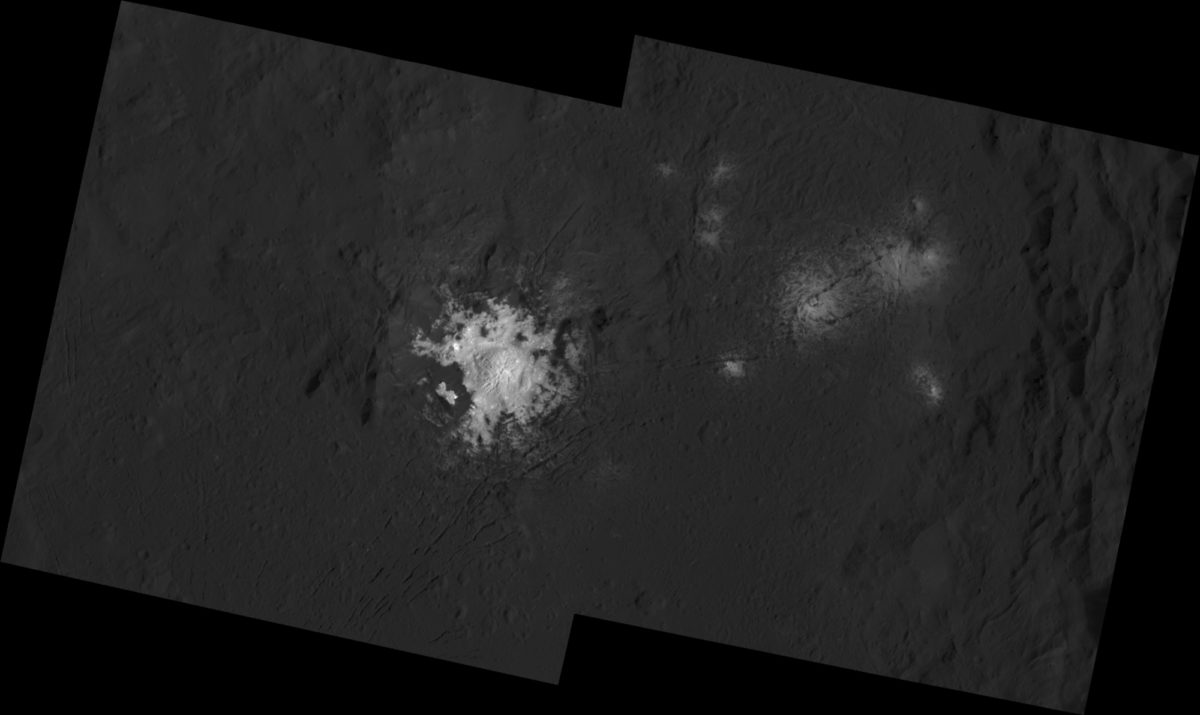
Schenk pointed out that Occator's bright central spot is a topographic depression "which we'll call a central pit because it has less syllables." My eyebrows shot up when I noticed the dome in the very center of that pit. The dome is fractured across its top. That suggests that the top of the dome extended and cracked as it was lifted up -- something was rising beneath Occator's central pit to build that dome, and the very topmost crust cracked like a Snickerdoodle cookie. Schenk commented that these sorts of pits and domes are also not seen in the Saturn system, "but they are very common on Ganymede and Callisto."
Carol Raymond spent some time at the Dawn press briefing describing the same photo. Here are my notes on what she said about it (transcribed, to the best of my ability, in real time):
We see that we have a very complex structure within that central complex. There is a dome right at the center, and material has filled in the depression, but there's a lot of irregularities in the central pit wall. The subsidiary bright spots are much less bright; the difference in brightness is a factor of two, and [the subsidiary spots are] a very diffuse set. There are also a lot of fractures that run through this area here, and we see these fractures elsewhere throughout Occator. Zoom in on the central pit, with color from HAMO data, and a couple of things pop out. The central dome has a different color tone than the surrounding material, and we also see these concentric fractures that define the central pit area, and in general the distribution material is quite irregular surrounding the dome. Fractures on the dome are radial, so the fracture patterns, the difference in color and overall geomorphology are suggesting to us that this is some recent activity within this crater. The crater is not that old, but it appears that material has come up from below and been emplaced in the central pit. We are investigating when this process occurred, whether it was recent or whether the material is just different, and what process brought this material to the surface.
Despite differences in detail, Cerean craters tend to look a lot like similar-size craters on Dione and Tethys, and very different from similar-sized craters on Vesta, Schenk said. Almost all of Vesta's craters are "deep bowls with no complex structure," while you have central peaks and polygonal and terraced craters on Ceres as you do on Saturnian moons. In terms of the shape of its craters, then, Ceres' crust behaves like the crust of icy moons, not dry rocks.
What makes up Ceres' crust? Intriguing clues are visible in fresh craters, which make bright splashes across Ceres. Whatever that bright stuff is, it's not ice (except maybe in one case -- more on that below). Ralf Jaumann reported on investigations of this bright stuff using multispectral imaging with Dawn's framing camera. A lot of Ceres' bright craters -- as well as its bright mountain Ahuna Mons -- are, spectrally speaking, blue. Spectral blueness for crater ejecta isn't particularly surprising; it's common on planetary surfaces for crater ejecta to be spectrally blue. Surfaces that have been exposed to space for a long time are reddened by space weathering, so fresher material is less red, hence, blue. In all cases, the recent, highest-resolution photos have proven that these bluish areas are much younger than redder areas. The center of Haulani, which has a weird central ridge surrounded by flow features, "looks crater-free," Jaumann said. What is this spectrally blue material? Jaumann couldn't determine whether it was compositional differences or physical differences (i.e. variations in particle size or porosity), though he favored the latter.
Jaumann found one thing particularly puzzling: that the blue stuff found in fresh crater ejecta is also found in the streaked flanks of bright Ahuna Mons. They don't seem to have released the color image he showed at the press briefing, but here's a beautiful high-resolution grayscale mosaic; just imagine the bright slopes as also being blue.

I asked Jaumann about all the different kinds of flow features visible in and around Ceres' craters. He said:
In general, we have flow features which are related to mass wasting [e.g. landslides], flow features which are related to volcanic activity, and flow features which are related to materials which are highly volatile. We see all of them on Ceres, which makes it, in another way, unique. They are mostly related to the impacts that we have, but it's not clear which materials are flowing. We have to look at the viscosity of the material. We can distinguish with geology between wet and dry flows; dry materials can flow if they have small particle size. Anything can be mobile. We see so many flow features on such a low gravity object. That's very interesting: it means material that we have is very low-viscosity and it can flow even when there is low gravity. We need more topographic information in order to understand this. That's a processing issue. We have the data, but it needs time to nail down topographic processing on the order of 35 meters per pixel. We did this for Vesta and we can do it for Ceres. We should be able to get height resolution on the order of a third of a pixel. Once we know what the process is, we can say which material has been flowing.
Christina de Sanctis reported on early results from the Visible and Infrared Spectrometer (VIR) from LAMO. In HAMO, VIR had acquired a global map at 400 meters per pixel. In LAMO, VIR is able to see at 100 meters per pixel, but has so far imaged a relatively small amount of the globe. Globally, a combination of magnesium-bearing clays, ammonium-bearing clays, magnesium carbonates, and some unknown dark component provide a good fit to Ceres' spectral colors in VIR wavelengths. Next, she tackled the bright regions, including the posts in Occator, the ejecta of Oxo and Haulani craters, and the flanks of Ahuna Mons. She said that among them all, Ahuna stands out for the strength of the carbonate signal in the spectra, whereas Oxo is the only place where exposed surface water is detected. She repeated her contention, said at the Division for Planetary Sciences meeting in the fall, that the presence of ammonium indicated an outer solar system source for Ceres surface materials (perhaps even Ceres itself). She concluded that Ceres' surface is a mixture of different materials that result from pervasive alteration by water: "Water is key."
Kynan Hughson looked a little more closely at Oxo crater, the only one on Ceres that shows a specific detection of water. He said it wasn't necessarily in the form of ice; the water could be bound into minerals as hydrated salts. But Oxo's far northern location makes it plausible that there is near-surface ground ice affecting the crater's geology, he said. Jean-Philippe Combe examined where specific VIR pixels showing water fell on camera images: 'The ice is associated with hummocky sloped material in the crater floor as well as margins of lobate flow structures" which could possibly be "ice-cemented flows." Both Hughson and Combe reported that the Dawn team plans to observe Oxo repeatedly to see if there is any change in its ice-related features with time. They haven't released high-resolution images of Oxo in color yet, but here is a lower-resolution 3D view that I made.

Simone Marchi made an intriguing observation about Ceres' craters. There are quite a lot of them; the Dawn team's map now includes 544 craters larger than 20 kilometers in diameter, and many smaller ones. For craters between 20 and 80 kilometers in diameter, Ceres is "saturated," meaning that each new crater obliterates, on average, one older crater, so that the number of craters stays constant with time. But at larger diameters, craters are missing -- there should be more craters of sizes greater than 100 kilometers than are observed. Models suggest that there should be 10 to 12 craters larger than 400 kilometers in diameter; Ceres has none. There ought to have been 180 craters larger than 100 kilometers, of which 40 would be observable today after all that battering; yet only 16 are observed.
Maybe, Marchi suggested, the big craters are just hard to spot: "let's try to squeeze the data and see if we can find something." Using the global topographic data set, he tentatively identified a few large-scale depressions; he was confident about one of them, less so about the other two. These may be the missing biggest basins, but he still can't find the mid-sized ones. Marchi explored a variety of hypotheses relating to collisional or orbital history to explain the missing mid-sized craters on Ceres, but couldn't make any of them work. "The answer for this conundrum needs to be some internal process," he said. "Internal evolution of Ceres is key to understanding its cratering record."
Some clues to Ceres' internal evolution can be found in the shapes of its craters (which are often polygonal) and in its global sets of fractures. Katharina Otto, Debra Buczkowski, and Jennifer Scully all reported on their efforts to map these features, but the work was fairly preliminary; they have made maps, but have much more work yet to do to interpret those maps and compare them with each other. Scully did report that one of Ceres' two global fracture sets has a geometry that points back to one of Marchi's basins as a possible source of the stresses that caused the fracturing. But the other set of fractures that she mapped didn't align with any obvious geological feature.
In general, the talks at LPSC continued to reinforce the conclusion, made at DPS, that Ceres' outer shell is not pure ice but rather a mixture of mostly rock and less ice. This rock-ice mixture may explain some of the interesting transitional geology found in Ceres' craters, as Paul Schenk described them. Under ordinary conditions, Ceres' crust is strong like rock. But when smashed in an impact, it behaves like ice. Impacts into this material produce flows that look like lunar impact melts, though on Ceres it would have been "more like an impact mud than an impact melt." Tim Bowling showed some geophysical modeling work in which he applied rock-like behavior for some physical conditions, and ice-like behavior for others. He was able to match the shape of Occator crater -- including its central pit -- with a model that used a rock-like strength for Ceres' crust, but where the crustal material responded to the shock waves of the impact to acoustically fluidize as ice does. The conclusion he drew is that the rocky component dominates the strength of Ceres' crust, allowing it to hold up topography; but when the crust is being stretched, the weakness of the ice allows it to be pulled apart. This work, like much of what I saw in the sessions, was preliminary, as Bowling acknowledged to chuckles from the audience: "My thinking on this has actually changed in the last 24 hours after a conversation with Gareth Collins and some hasty reanalysis."
Julie Castillo-Rogez presented some early work on the puzzle of how an ice-rich Ceres can lack a pure ice shell. If you start out with a mixture of ice and rock in a body as massive as Ceres, and melt any of the water, gravity really ought to force the rock to drop to the center and the water to float to the top, stratifying it into an ice mantle over a rocky core. As the water freezes, it even excludes salt, forming a pure ice layer at the very top, as with the icy moons of the outer solar system. But that's not what we see at Ceres. Instead, Castillo-Rogez said, we see this mixture of ice and rock, as well as spectral evidence for minerals that formed at higher pressures. Is it possible that Ceres once did have a pure ice shell, but has since lost it? She suggested that impact-induced sublimation could have caused Ceres to lose up to 50 kilometers' thickness of ice shell in 100 to 200 million years of bombardment.
All in all, three days of Ceres was a lot to swallow, and it's taken me another three days to try to absorb it all and summarize the presentations in this post. We'll continue to drown in data from Dawn for as much as another year, and then the mission will be over. I fully expect it to take decades for scientists to get everything that they can out of this rich data set.
Support our core enterprises
Your support powers our mission to explore worlds, find life, and defend Earth. You make all the difference when you make a gift. Give today!
Donate

 Explore Worlds
Explore Worlds Find Life
Find Life Defend Earth
Defend Earth

